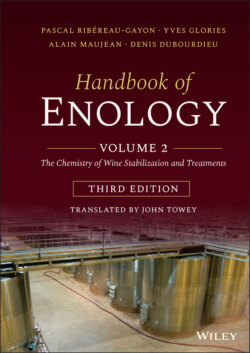Читать книгу Handbook of Enology, Volume 2 - Pascal Ribéreau-Gayon - Страница 58
2.4 Aliphatic FattyAcids
ОглавлениеThese aliphatic fatty acids are shown in Table 2.4. The most important of these compounds is acetic acid, the essential component of volatile acidity. Its concentration, limited by legislation, indicates the extent of bacterial activity (lactic acid bacteria or acetic acid bacteria) and the resulting spoilage of the wine. As yeast forms a small amount of acetic acid, there is some volatile acidity in all wines. Other C3 (propionic acid) and C4 acids (butyric acids) are also associated with bacterial spoilage.
The C6, C8, and C10 fatty acids are formed by yeast. As they are fermentation inhibitors at concentrations of only a few milligrams per liter, they may be responsible for stuck fermentations (Volume 1, Section 3.6.2).
Unsaturated long‐chain fatty acids (C18 and C20) are related to the sterol family. These compounds are fermentation activators, particularly under anaerobic conditions (Volume 1, Section 3.5.2). The most important of these are oleic (C18 with one double bond) and linoleic (C18 with two double bonds) acids. They are active in trace amounts and come from the waxy cuticle of grape skins. Under the name “fatty acids,” there are thus two families of compound with fundamentally different properties.
